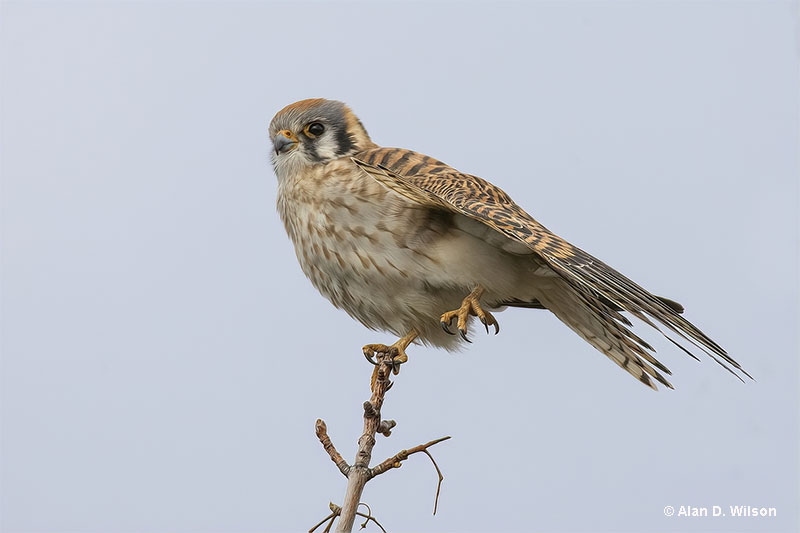
There are 6 species of falcons that reside in North America. However, identifying falcons can prove to be rather challenging. Some species can have dark and light morphs, and juvenile and adult plumages can look extremely similar.
Fortunately, even if you can’t tell a falcon species by certain characteristics, like their plumage, they can be identified by a variety of other factors, including their type of flight, vocalizations, and range.
On this page
Types of All 6 Falcons in the United States
American Kestrel
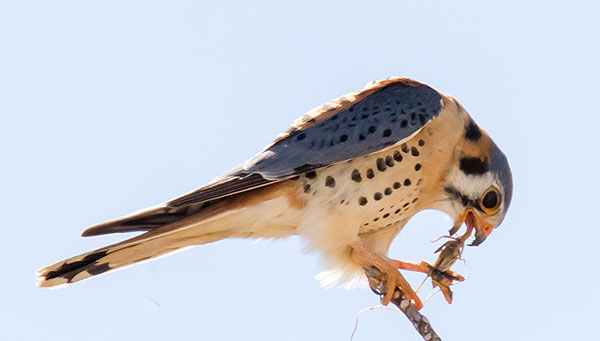
American Kestrels have large heads, square-tipped, long tails, and narrow, long wings. Overall these birds are about the same as a mourning dove.
American Kestrels are rusty, warm brown with spots of black above, have a black band near the tip of the tail, and are pale below. Both males and females have pairs of black vertical lines on the sides of their faces. However, female Kestrels have reddish-brown wings, and male Kestrels have slate-blue wings.
Related: What do falcons symbolize?
American Kestrels prefer to inhabit open areas with sparse trees and short-ground vegetation.
You’ll find them in suburbs, meadows, deserts, grasslands, parks, cities, and farm fields.
Merlin
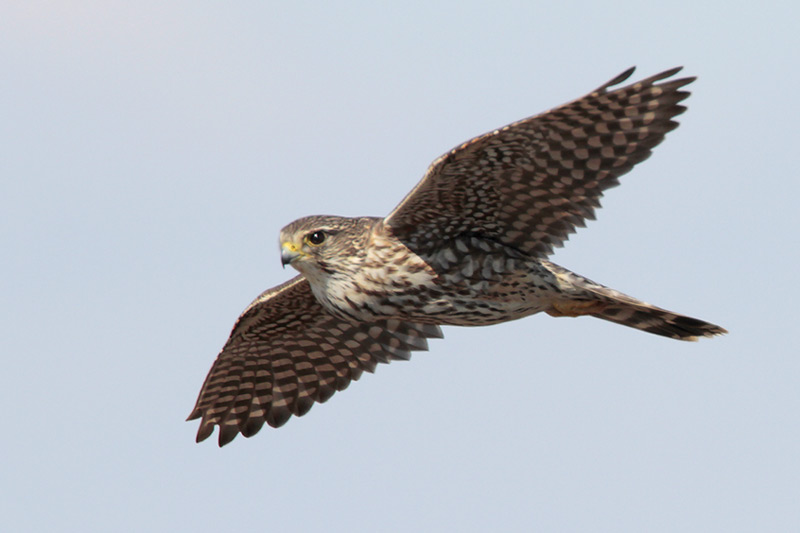
Merlins are smaller falcons with a powerful build. They have medium-length tails, broad chests, and sharply pointed wings. They’re stockier, broader, and a little bit smaller than the American Kestrel.
Merlins are usually streaky and dark, but their coloration can vary due to gender and geography.
Adult males are dark gray to slaty gray while immatures and females are browner. The underwings are dark, the chest is often heavily streaked, and their dark tails have small white bands.
Merlins are birds that nest in forest edges, forested openings, and along rivers across the northern portions of North America. Recent research has found that they’ve also started nesting in cities and towns.
Gyrfalcon
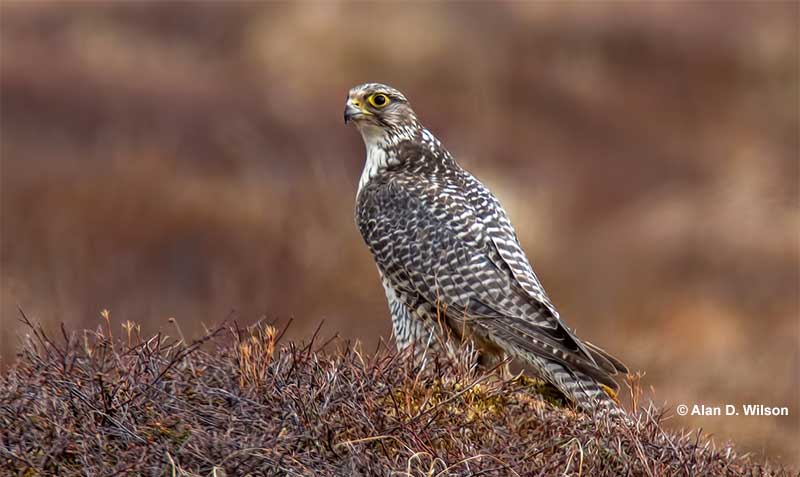
Gyrfalcons have pointed wings, relatively long tails, and powerful, thick bodies. They’re very large falcons, especially females, who are significantly larger than males.
The classic image of these birds is regal white with black spotting. However, Gyrfalcons occur in shades of dark brown, gray, and white. In North America, gray birds are more common.
Overall, adult birds are heavily barred on the tail, wings, and back and have spotted underparts. Juveniles are heavily streaked, and their flight feathers are lighter in darker individuals.
These falcons breed on the arctic tundra. When they migrate south for the winter, they look for similar habitats, including shrubsteppe, prairie, dunes, coastlines, and open fields.
Peregrine Falcon
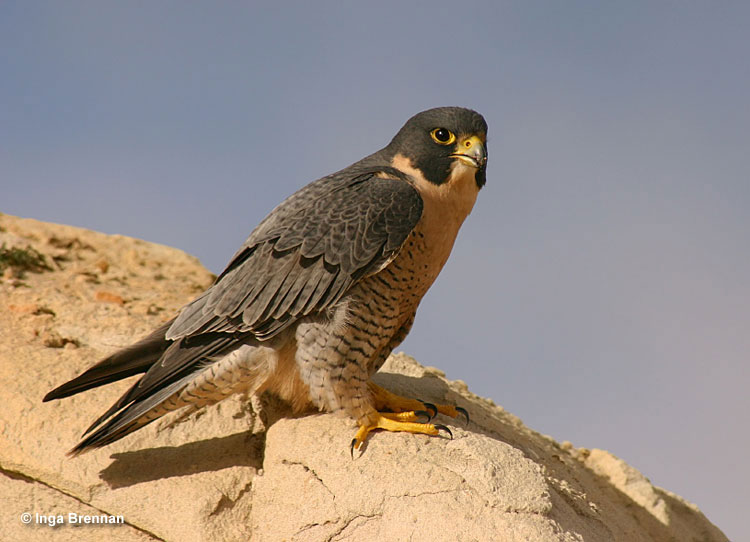
Peregrine Falcons are the largest falcon in most of North America. They have long tails and pointed long wings. Female Peregrine Falcons are larger than males.
Related: Fastest birds in the world
Adult Peregrin Falcons have dark heads with bold sideburns, have barred underparts, and are blue-gray above. Juveniles have vertical streaks on the breast and are heavily marked.
Despite the considerable geographic and age-related variation, an overall barred, steely look remains.
Peregrine Falcons can often be seen nesting or perching on tall structures like power pylons, cliffs, and skyscrapers. Peregrine Falcons can be seen throughout North America, but they are most commonly seen along the coast.
Prairie Falcon
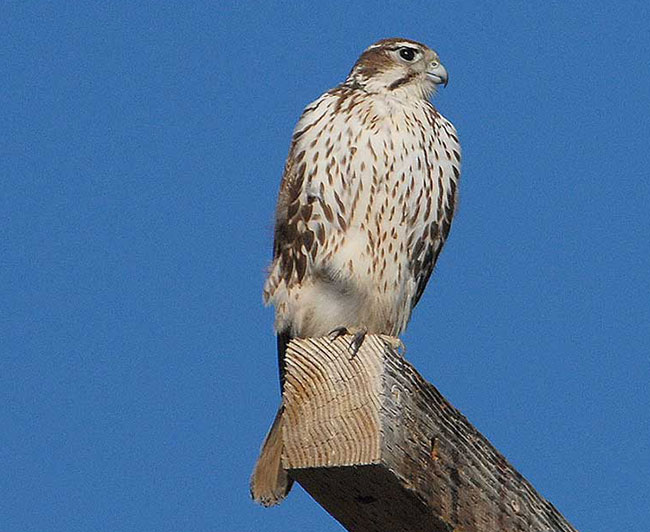
Photograph © USFWS
Prairie Falcons are large falcons with medium-length tails and pointed wings. They’re about the size of Peregrine Falcons.
Prairie Falcons are pale with brown markings on the belly and breast and are brown above. If viewing them from below, you’ll see that under their wings are dark from the wrist to the “armpit.”
If viewing them from above, their back and wings really contrast their pale tail. Additionally, they have a brown mustache stripe and a pale stripe above the eye.
Prairie Falcons can be found in the West in wide-open habitats. Some of their habitats include agricultural fields, prairie, desert, and sagebrush.
They build their nests on sheer rocky cliff edges.
Crested Caracara
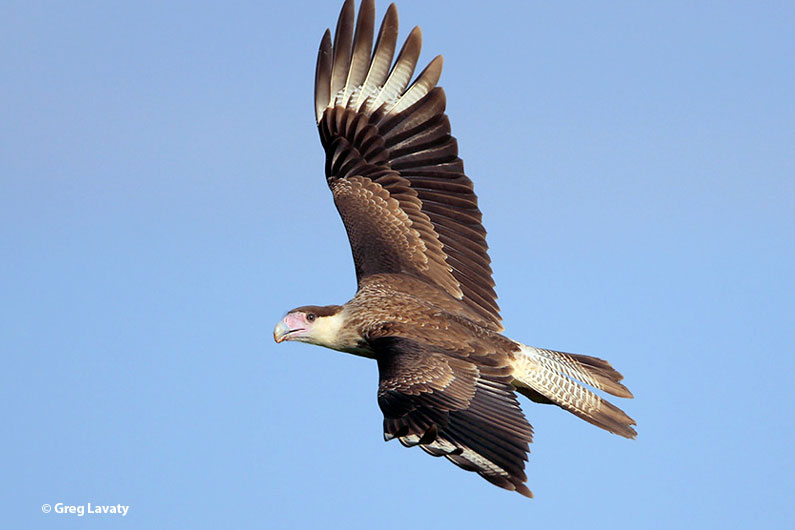
The Crested Caracara is a bulky, medium-sized raptor. They have flat heads, shaggy crests, heavy bills, and long legs. When flying, their diamond-shaped tails and straight, long wings are noticeable.
Crested Caracaras have yellow legs and yellow-orange skin around their bills and are white and black overall. Their white neck and cheeks contrast strongly with their black cap.
When in flight, the outer flight feathers and the under tail can be seen, which are white.
However, on the contrary, juvenile birds are white and brown and lack the yellow-orange facial skin and legs seen in adults.
Crested Caracaras prefer to inhabit open country, including savannas, scrub, deserts, cultivates areas, and pastures. They perch on fences, poles, and scattered trees to get a better view of their surroundings.
Tips to Identifying Falcons
There are a few different characteristics you can look for when trying to identify if a bird is a falcon or not. Here are the most common characteristics seen in falcons:
- Falcons are birds that have very stiff feathers. Additionally, their bodies are bullet-shaped and sleek, which helps them move through the air with less resistance in comparison to other raptors.
- Falcons tend to fly faster than hawks that are close to their size because they have pointed, long wings.
- Most species of falcons have cap-like patterns. These distinct dark malar stripes extend below their eyes to reduce the sun’s glare.
- Falcons have structures in their nostrils called tubercles. These structures act like a baffle to slow down the amount of air that rushes into their lungs when moving at higher speeds.
- Unlike eagles and hawks, falcons have a tomial tooth. This tooth is a protrusion on the upper bill and is used to cut the vertebrae of their prey.
Falcon Identification – Frequently Asked Questions
How do you identify a falcon?
You can identify a falcon by looking for specific characteristics. Some of the traits you can look for include stiff feathers, bullet-shaped, sleek bodies, pointed, long wings, and a tomial tooth.
Is a falcon a raptor?
Yes, falcons are raptors. The term “raptor” is used for a group of birds that consists of owls, vultures, eagles, kites, falcons, and hawks.
What is the most common falcon?
The most common falcon is the Peregrine Falcon. They are among the world’s most common falcons because they live on all continents except Antarctica.
What type of falcon is rare?
The rarest species of falcon is the Mauritius Kestrel. They’re so rare because they’re endangered. In 1977, only 4 birds were known to exist in the wild. Now there are over 800 of these birds in the wild. Unfortunately, their numbers are decreasing.
Can you touch a falcon?
You can touch falcons, but you shouldn’t unless it’s absolutely necessary. They can cause you harm with their beaks and talons and are known to keep their feathers pristine so they can hunt successfully.
What is the difference between a hawk and a falcon?
The 2 main difference between hawks and falcons is their beaks and heads. Falcons have a “tooth” at the end of their beaks, while hawks do not. Additionally, hawks have pointy heads, while falcons have rounded, short heads.
Is it lucky to see a falcon?
Yes, it is lucky to see a falcon! It’s believed that seeing a falcon means you’re approaching a new chapter in your life.

